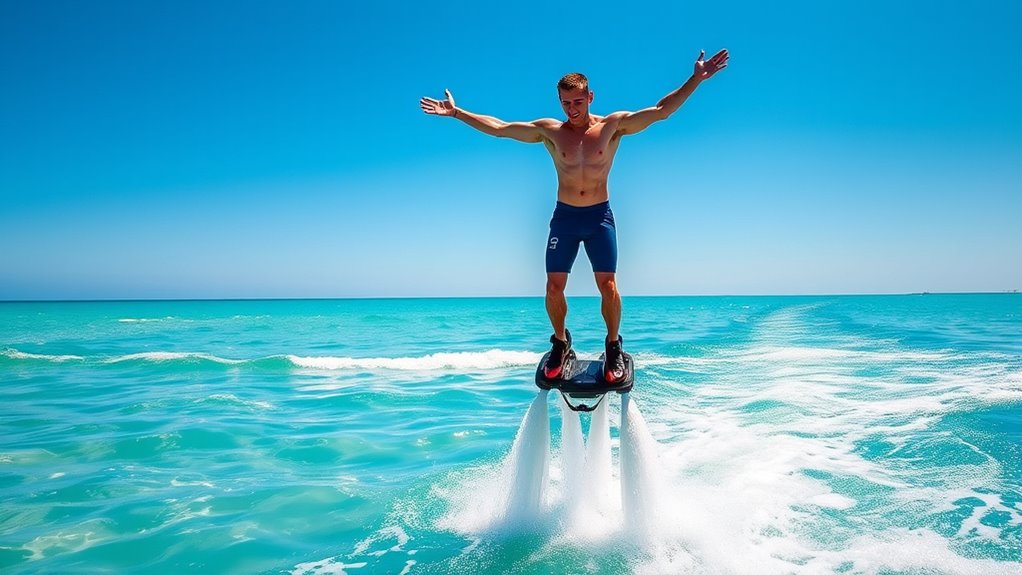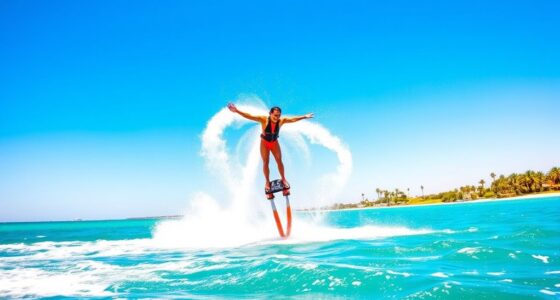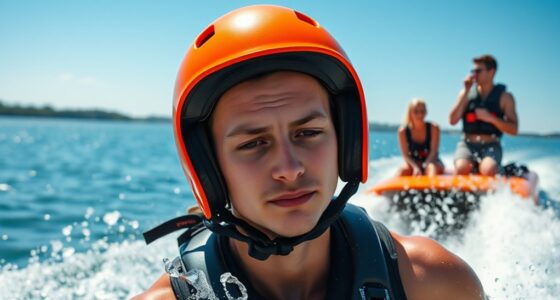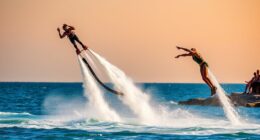Flyboarding training’s fantastic for building your core strength and balance. As you glide over the water, you’ll engage your lower back, abs, and legs, enhancing stability and control. Mastering balance is key to flying upright, while each session boosts your confidence and skill. Plus, the thrill of conquering the skies makes the effort worthwhile. If you’re enthusiastic to improve your technique and enjoy the ride even more, there’s plenty more to explore about this exhilarating sport.
Key Takeaways
- Flyboarding primarily engages core muscles, enhancing stability and control during flight.
- Focus on activating lower back, abs, and legs to improve balance while riding.
- Consistent practice builds core strength, leading to better overall flyboarding performance.
- Mastering balance techniques contributes to increased confidence and skill in the air.
- Expect muscle fatigue as you train, indicating strength development over time.

Have you ever dreamed of soaring above the water like a superhero? Flyboarding offers you that exhilarating experience, letting you hover, dive, and twist through the air while harnessed to a jet ski. It’s not just about the thrill, though; mastering flyboarding requires building core strength and balance, both essential for an enjoyable and safe ride. As you gear up for your first flyboarding adventure, it’s vital to prioritize water safety and equipment maintenance.
Before you hit the water, familiarize yourself with the safety protocols. Always wear a life jacket and ensure you understand the signals used between you and your instructor. Knowing how to communicate effectively can make a world of difference when you’re in the air, especially if you need assistance. You’ll want to pay attention to your surroundings, too. Watch out for other watercraft and be aware of currents. With a solid grasp of safety measures, you’ll feel more confident as you take to the skies.
Familiarize yourself with safety protocols and communication signals to ensure a confident and safe flyboarding experience.
Once you’re suited up and ready, it’s time to focus on your core strength and balance. Flyboarding engages your entire body, demanding stability and control. As you rise above the water, your core muscles will activate to keep you upright and steady. You’ll likely find that your lower back, abs, and even your legs play a significant role in maintaining your position. Don’t be surprised if you feel some muscle fatigue; that’s your body working hard to adapt to this new activity, and it’s part of building your strength.
Equally important is the maintenance of the equipment you’ll be using. Confirm the flyboard and jet ski are in excellent condition before you start. Check for any signs of wear or damage, as malfunctioning equipment can pose risks to your safety. A little effort here goes a long way, ensuring not just your safety but also a smoother and more enjoyable experience. If you notice anything amiss, address it with your instructor or the operator before taking off.
As you learn to balance and maneuver, you’ll discover the joy of flying. Each attempt brings you closer to mastering this unique sport. With your focus on water safety and proper equipment maintenance, you’re setting yourself up for a fun and successful flyboarding experience that’ll leave you feeling like you can conquer the skies. So strap on that flyboard and get ready to release your inner superhero!
Frequently Asked Questions
What Equipment Is Needed for Flyboarding Training?
For flyboarding training, you’ll need a few key pieces of equipment. First, safety gear is essential—wear a helmet, life jacket, and possibly knee and elbow pads. You should also invest in a good quality flyboard and a personal watercraft to provide the necessary propulsion. Participating in training courses can help you learn proper techniques and safety measures, ensuring you get the most out of your flyboarding experience while staying safe.
How Long Does a Typical Flyboarding Session Last?
A flyboarding session usually lasts about 30 to 60 minutes, like a dance with the waves, where you learn to balance and glide. During this time, you’ll focus on water safety, ensuring you’re aware of your surroundings and equipment maintenance, to keep everything in top shape. Each moment spent on the water builds your skills and confidence, making every session feel like a step closer to mastering the art of flyboarding.
Is Prior Experience Required for Flyboarding Beginners?
No prior experience is required for flyboarding beginners. However, it’s essential to follow safety precautions to guarantee a great experience. Start by listening to your instructor’s beginner tips, like maintaining proper posture and using your core for balance. Don’t rush; take your time to get comfortable on the board. With practice, you’ll find your rhythm and enjoy the thrill of flyboarding while staying safe. Embrace the learning curve!
Are There Age Restrictions for Flyboarding Training?
Yes, there are age restrictions for flyboarding training. Most operators set age limits around 12 years old, but it varies by location. Safety considerations are vital, so younger participants often need parental consent and supervision. If you’re underage, check with your local provider for their specific rules. It’s important to make certain that everyone can enjoy the experience safely, so always prioritize age guidelines when planning your flyboarding adventure.
Can Flyboarding Be Done in Any Body of Water?
Flyboarding’s like dancing on water; it can be done in any body of water, but you must prioritize water safety first. Choose locations with enough depth and space to maneuver freely. Always check for obstacles and currents. Regular equipment maintenance is essential to guarantee your flyboard operates smoothly. By being mindful of your surroundings and keeping your gear in top shape, you’ll enjoy a thrilling experience while staying safe on the water.
Conclusion
So, while you might think flyboarding’s just about zipping through the air, it’s really a sneaky workout for your core and balance. You’re having a blast, feeling like a superhero, but in reality, you’re sweating buckets, building strength, and mastering stability. Who knew that soaring above the water could be your ticket to a stronger core? Embrace the irony—while you’re flying high, you’re actually grounded in the fundamentals of fitness.










